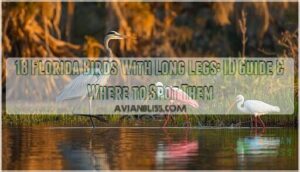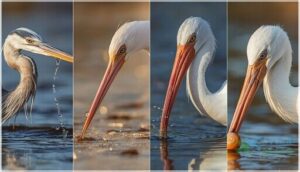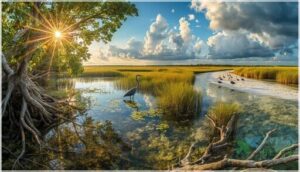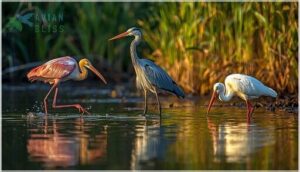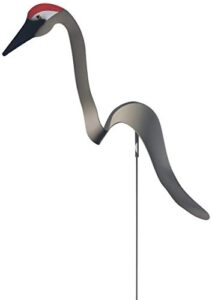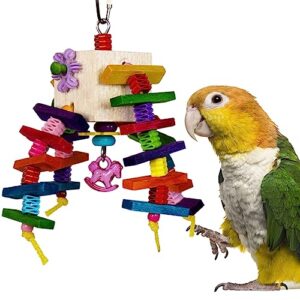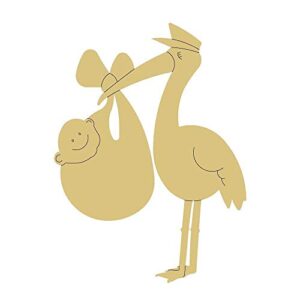This site is supported by our readers. We may earn a commission, at no cost to you, if you purchase through links.
When you stand at the edge of a Florida marsh at dawn, legs become everything. A Great Blue Heron freezes mid-step, its stilts poised four feet above the waterline, while a Roseate Spoonbill sweeps its coral-pink legs through the shallows like a painter working a canvas. These aren’t just anatomical quirks—they’re evolutionary masterpieces that let Florida birds with long legs access food sources other species can’t touch, wade through depths that would drown their shorter-legged cousins, and claim territories across the state’s vast wetland empire.
From the mangrove-lined coasts of the Everglades to the brackish marshes of the Panhandle, eighteen species have turned leg length into an art form, each with distinct hunting styles, plumage patterns, and habitat preferences that make identification both challenging and rewarding for anyone willing to look beyond the obvious.
Table Of Contents
- Key Takeaways
- Iconic Long-Legged Birds of Florida
- How to Identify Florida’s Long-Legged Birds
- Adaptations of Florida’s Long-Legged Birds
- Top 5 Products for Florida Bird Enthusiasts
- Frequently Asked Questions (FAQs)
- What birds live in Florida?
- What birds have long legs?
- What bird has red legs?
- What is a long-legged bird known for?
- Is Florida a bird-friendly state?
- Where do long-legged birds live in North America?
- What are the big birds with long legs in Florida?
- What are the 4 foot birds in Florida?
- Why are sandhill crane illegal in Florida?
- What is the difference between an egret and a great egret?
- Conclusion
Key Takeaways
- Florida’s eighteen long-legged wading bird species—including herons, egrets, spoonbills, and storks—have evolved specialized leg lengths that allow them to access deeper water, claim exclusive foraging territories, and hunt prey that shorter-legged competitors can’t reach across the state’s diverse wetland ecosystems.
- You can identify these species by combining multiple field marks: leg color (pink in Roseate Spoonbills, yellow-toed in Snowy Egrets, black in Wood Storks), bill shape (spear-like in herons, spatulate in spoonbills, downward-curved in ibises), and habitat preference (freshwater marshes for Limpkins, coastal saltwater flats for Black-necked Stilts).
- Physical adaptations like elongated necks enable rapid prey strikes while keeping bodies dry, specialized bill morphology determines feeding strategy (stabbing versus sifting versus probing), and plumage patterns provide camouflage against specific backgrounds—white feathers blur into sun-bleached reeds while mottled browns fracture outlines in dense vegetation.
- Conservation depends on protecting Florida’s wetland hydrology and coastal habitats, since species like Wood Storks require precise water levels for tactile feeding, while breeding colonies concentrate in mangroves and cypress stands where habitat preservation efforts directly determine population stability.
Iconic Long-Legged Birds of Florida
Florida’s wetlands, coastlines, and marshes are home to some of the most striking long-legged birds you’ll find anywhere in North America. From the towering Great Blue Heron to the vibrant Roseate Spoonbill, each species has adapted unique features that help it thrive in the Sunshine State’s diverse habitats.
Many birders discover these species up close through guided birdwatching trips along Florida’s East Coast, where expert-led excursions focus on wetland habitats.
Here’s your guide to 18 iconic wading birds you can spot across Florida’s waterways.
From herons and egrets to spoonbills and ibises, Florida’s diverse bird species offer year-round viewing opportunities for nature enthusiasts.
Great Blue Heron
You’ll spot the Great Blue Heron (Ardea herodias) standing nearly four feet tall with a striking 5.5-foot wingspan across Florida’s wetlands and coasts.
These patient hunters are just one of many fascinating species you’ll encounter among water birds in Florida, where diverse wetland habitats support an incredible variety of wading and aquatic birds.
This master wader stalks shallow waters year-round, spearing fish and amphibians with surgical precision. Watch for its slow, deliberate hunting style—patience personified on those impossibly long legs that let it wade where others can’t reach.
Its statuesque form is a familiar sight among backyard birds of Delaware, especially near wetland edges where shallow water meets shore.
Great Egret
You’ll recognize the Great Egret by its dazzling white plumage and yellow lore, standing over three feet tall across Florida’s wetlands. These wading birds master the art of patient hunting, using leg adaptation to access deeper waters where fish and crustaceans thrive.
Their impressive height places them among Florida’s most distinctive birds with long legs, sharing wetland habitats with herons and cranes that use similar wading strategies.
Watch for their elegant nesting habits in coastal colonies during spring, a demonstration of successful wetland conservation and bird conservation efforts that pulled them back from the brink.
Snowy Egret
You’ll spot the Snowy Egret (Egretta thula) by its striking black feet with distinctive yellow toes, a field mark that sets it apart from its larger white-plumed cousins. These wading birds measure 23 to 27 inches long and thrive year-round in Florida’s coastal marshes and wetlands, where habitat preservation efforts have boosted their numbers dramatically.
Key Identification Features:
- All-white plumage with black legs and bright yellow feet
- Slender black bill turning red during breeding season
- Active feeding strategies including foot-stirring and rapid pursuit
- Nesting behaviors in colonial sites near shallow water
- Year-round resident with stable conservation status across Florida
Tricolored Heron
The Tricolored Heron (Egretta tricolor) displays a blue-gray body with a white belly and reddish-brown neck stripes, making it unmistakable among Florida wading birds.
You’ll find these herons stalking through brackish marshes and mangrove edges year-round, where they use slow-stalk foraging techniques to catch small fish and crustaceans. Their slender build and olive legs distinguish them from other long-legged Florida birds in coastal wetland ecology systems.
Little Blue Heron
The Little Blue Heron (Egretta caerulea) might fool you at first—juveniles wear white plumage before molting into slate-blue adults with maroon neck highlights, measuring 24 to 28 inches.
You’ll spot these herons stalking freshwater marshes and coastal lagoons year-round across Florida, where their patient foraging tactics and distinctive leg structure make them masters of shallow-water hunting during bird watching expeditions.
Reddish Egret
The Reddish Egret (Egretta rufescens) puts on a show unlike any other wading bird, dancing through shallow saltwater flats with wild, zigzagging sprints and sudden wing flares that make it look slightly unhinged—but this chaotic hunting style works brilliantly. You’ll find these 30-inch performers patrolling Florida’s coastal ecosystems, where their distinctive foraging tactics and pink-based bill make them unmistakable during bird watching in Florida:
- Shaggy head plumes give adults a perpetually windswept appearance
- Two color morphs exist: dark phase (reddish-brown) and white phase
- Long leg structure allows rapid pursuit of fish in ankle-deep water
- Habitat conservation remains critical as only 2,000 breeding pairs exist in North America
- Feather maintenance includes regular preening to maintain water-repellent properties
Green Heron
Compact and cunning, the Green Heron (Butorides virescens) breaks the stereotype of towering wading bird species—you’ll spot this 18-inch hunter year-round in Florida’s marshes, mangroves, and shaded canals, where olive-green feathers and relatively short legs suit its stealthy approach.
Watch for striking heron behavior: dropping insects as bait to lure fish, a documented foraging tactic that makes bird watching in Florida unforgettable while highlighting the importance of bird conservation in wetland habitats supporting heron migration.
Cattle Egret
Cattle Egret (Bubulcus ibis) populations have surged across Florida—you’ll find these medium-sized white herons, 18–22 inches tall with yellow-green legs, trailing livestock in pastures and wetlands, where foraging strategies involve snatching insects flushed by grazing animals.
- Breeding plumage shows buff-orange patches on crown, back, and chest
- Nesting colonies form in trees near marshes, often alongside other egrets and herons
- Year-round residents demonstrate exceptional bird adaptations, thriving where wetland ecology meets agricultural habitat conservation
Wood Stork
Standing nearly 4 feet tall, Wood Stork (Mycteria americana) colonies transform Florida’s cypress and mangrove wetlands into bustling nurseries. You’ll recognize these wading birds by their naked black heads, white plumage, and thick downward-curved bills designed for tactile feeding in murky waters.
| Feature | Description | Best Spotting Season |
|---|---|---|
| Wood Stork Habitat | Freshwater marshes, mangroves, floodplains | Year-round, peak nesting winter-spring |
| Stork Feeding Habits | Tactile “grope-feeding” in shallow water | Dawn and dusk |
| Bird Conservation Efforts | Wetland ecology restoration protects colonies | Ongoing habitat management |
| Stork Migration Patterns | Post-breeding dispersal across Southeast | Summer-fall wandering |
Long-legged Florida birds like these depend on precise water levels. Bird watching enthusiasts should explore preserves where wetland ecology sustains their foraging, as bird conservation efforts focus on maintaining the hydrology these wading birds require for survival.
Roseate Spoonbill
With its cotton-candy plumage and spatula-shaped bill, you’ll spot the Roseate Spoonbill (Platalea ajaja) sweeping through Florida’s coastal marshes like a living work of art. These wading birds’ characteristics make them unmistakable:
- Feeding Strategies: Tactile bill probing detects crustaceans in muddy shallows
- Nesting Behaviors: Colonial breeding in mangrove sanctuaries with other long-legged Florida birds
- Spoonbill Migration: Seasonal shifts follow tidal patterns across southern wetlands
- Conservation Status: Habitat preservation efforts maintain stable populations in protected refuges
American Flamingo
You won’t mistake the American Flamingo (Phoenicopterus ruber) for anything else in Florida’s coastal lagoons. Reaching 3.3 to 4.6 feet tall with pink feathers powered by crustacean pigments, these wading birds’ characteristics include specialized beak structures for filter-feeding and colony behavior in breeding groups. Though rare visitors here, their conservation status reflects successful Caribbean populations, with flamingo migration occasionally bringing them to southern wetlands.
| Feature | Description |
|---|---|
| Height | 3.3-4.6 feet tall |
| Wingspan | 4.3-5.3 feet across |
| Leg Color | Pale pink, exceptionally long |
| Diet | Crustaceans, algae (filter-feeding) |
| Habitat | Coastal lagoons, saline flats |
White Ibis
You’ll spot the White Ibis (Eudocimus albus) year-round across Florida’s coastal and inland wetlands, where habitat conservation and wetland ecology support thriving populations. These wading birds’ characteristics include pure white plumage that aids feather camouflage against bright backgrounds, a distinctive down-curved orange bill, and long pink legs adapted for shallow-water foraging:
- Height ranges from 22 to 27 inches
- Wingspan measures 35 to 41 inches
- Diet consists of crustaceans, insects, small fish
- Breeding colonies form in trees near water
- Juveniles display brown plumage before molting
Their ibis behavior includes probing mud with specialized bills, and bird migration patterns bring seasonal population fluctuations. For bird identification, note the striking orange bill and pale legs—key features distinguishing White Ibis among long leg Florida birds.
Limpkin
You’ll encounter the Limpkin (Aramus guarauna) wading through Florida’s freshwater marshes, where limpkin habitat and freshwater ecology create prime conditions for its snail diet. These long-legged Florida birds showcase distinctive wading bird characteristics—brown plumage with white streaking, a slightly upturned bill, and gray-green legs. Wetland conservation sustains populations, while bird migration is minimal.
For bird identification among Florida birds, listen for their unmistakable wailing cry echoing across marshes.
| Feature | Description | Function |
|---|---|---|
| Bill | Long, slightly upturned | Extracting apple snails |
| Plumage | Brown with white streaks | Camouflage in vegetation |
| Call | Creaky, piercing rattle | Territory defense |
| Foraging | Slow, deliberate probing | Locating hidden prey |
| Habitat | Freshwater wetlands | Access to snail populations |
Black-necked Stilt
You’ll spot the Black-necked Stilt (Himantopus mexicanus) foraging across Florida’s coastal mudflats and brackish marshes, where stilt migration and wetland ecology intersect. This striking wading bird showcases remarkable leg adaptation—pale pink legs stretching nearly twice its body height—paired with bold black-and-white plumage.
Habitat conservation efforts support breeding populations in managed wetlands, while bird behavior includes deliberate probing for invertebrates in shallow water, making these long-legged birds unmistakable among Florida’s shorebird communities.
Long-billed Curlew
You’ll rarely encounter the Long-billed Curlew (Numenius americanus) in Florida, as curlew migration brings these massive shorebirds primarily to Gulf Coast prairies during winter months. Habitat preservation of open grasslands facilitates sporadic sightings from October through March.
With its downward-curved bill stretching up to 8.5 inches, this bird represents Florida’s largest shorebird, though wildlife research confirms it’s an uncommon visitor rather than a resident species.
Willet
You’ll find the Willet (Tringa semipalmata) along Florida’s tidal flats and coastal marshes, where shorebird habitat maintains year-round populations and migratory visitors from northern breeding grounds. Willet migration peaks bring concentrations to Gulf and Atlantic coasts, offering prime birdwatching opportunities for longlegged birds enthusiasts invested in coastal wildlife and wetland ecology:
- Grayish-brown plumage during non-breeding seasons provides camouflage
- Distinctive white belly and dark wing tips visible in flight
- Long, straight bill for probing mudflats for crustaceans
- Probes for crabs, mollusks, and invertebrates in shallow water
- Bird conservation efforts protect critical shorebird habitat across Florida
Whimbrel
You’ll recognize the Whimbrel (Numenius phaeopus) by its distinctively long, downward-curved bill and bold dark crown stripe, features that set this shorebird apart during Florida birdwatching excursions along coastal mudflats and mangrove zones.
Whimbrel migration brings spring and fall passage birds through shorebird habitat, where these long-legged birds probe tidal areas for invertebrates, making Whimbrel conservation efforts essential for protecting critical coastal foraging grounds.
Short-billed Dowitcher
You’ll spot the Short-billed Dowitcher (Limnodromus griseus) among Florida birds by its exceptionally long, straight bill, perfect for probing coastal mudflats during migration patterns.
This medium-sized wading bird favors tidal flats and estuaries for feeding habits, where flocks pursue invertebrates like polychaetes and bivalves.
Habitat selection focuses on Gulf and Atlantic coastlines, making these shorebirds reliable winter visitors rather than year-round residents.
How to Identify Florida’s Long-Legged Birds
You don’t need a field guide the size of a textbook to tell these wading birds apart. Once you know what to look for—leg color, bill shape, where they hang out—identification becomes second nature.
Here are the key features that’ll help you put a name to every long-legged bird you spot in Florida’s wetlands and coastal areas.
Key Physical Features (Leg Color, Neck Length)
You’ll notice leg color right away when you’re scanning the shallows—it’s one of the fastest field marks to separate a pink-legged Roseate Spoonbill from the yellow-footed Snowy Egret. Understanding the role of wetland bird habitats is essential for identifying these species. Neck length matters too—wading birds’ characteristics include proportionally elongated necks that let them strike at prey while keeping their bodies dry.
Here’s what you should watch for in Florida birds with long legs:
- Leg coloration: Ranges from bright pink (Roseate Spoonbill) to yellow (Snowy Egret), black (Wood Stork), or reddish-pink (Black-necked Stilt)
- Neck length: Great Blue Herons have extremely long S-curved necks, while Green Herons appear compact and stocky
- Body proportions: Birds with long legs often show disproportionately elongated limbs relative to body mass, enabling deeper wading
- Feather patterns: Look for contrasting plumage like the Tricolored Heron’s white belly against blue-gray upper parts
- Beak shapes: Note whether bills are straight, curved, or spatula-shaped before moving to feeding behavior analysis
Bill Shape and Feeding Habits
Bill shape telegraphs feeding strategy in Florida’s wading birds—precision tools honed by evolution. Herons and egrets carry sharp, spear-like bills for stabbing fish and amphibians, while spoonbills sweep laterally flattened bills through shallows to sift invertebrates. Ibises probe mud with downturned beaks hunting hidden prey.
Bill shape reveals feeding strategy—herons spear fish with daggers, spoonbills sift shallows, ibises probe mud for hidden prey
Understanding bill adaptations reveals foraging techniques—longer bills access deeper sediment layers, while shorter versions suit surface gleaning.
| Bill Shape | Primary Feeding Strategy | Target Prey |
|---|---|---|
| Spear-like (straight, pointed) | Precision stabbing, stalking | Fish, amphibians, small vertebrates |
| Spatulate (flattened, broad) | Sweeping, sifting through water | Small invertebrates, crustaceans |
| Decurved (downward curve) | Probing soft substrate | Buried invertebrates, worms |
| Hooked (curved tip) | Grasping, prying | Mollusks, larger invertebrates |
Habitat Preferences and Locations
Florida’s long-legged wading birds partition across distinct wetland ecosystems and coastal habitats. Shorebirds in Florida concentrate along estuarine areas and beaches, while herons favor freshwater sources like marshes and lakes. Mangrove forests shelter roseate spoonbills and reddish egrets.
Everglades National Park and the Florida Keys refuges provide critical foraging grounds. Wildlife conservation in Florida depends on protecting these habitat preservation zones where species distributions reflect hydrological patterns and prey availability.
Seasonal Vs. Year-Round Species
Understanding migration patterns helps you separate temporary visitors from year-round residents. Great Blue Herons, Wood Storks, and White Ibis maintain stable populations across all seasons in core wetland zones, supporting bird conservation efforts.
Seasonal habitat shifts bring shorebirds during spring and fall migrations, creating fluctuating species distribution:
- Migratory shorebirds peak during spring and autumn passages
- Southern wetlands host persistent heron and egret colonies
- Breeding cycles create localized concentration periods
- Water management influences wading birds’ seasonal presence
- Food pulses drive transient increases in bird species numbers
Unique Behaviors and Calls
Beyond timing your visits around migration windows, watching how these birds actually move and communicate reveals their true identities—Reddish Egrets dance through shallows with erratic lunges, while Limpkins broadcast their haunting wails across marshes at dusk. Vocalization patterns distinguish species: Great Egrets produce harsh croaks during mating rituals, whereas Snowy Egrets emit softer notes. Foraging strategies reveal bird anatomy adaptations, as Cattle Egrets follow livestock while herons employ patient stalking techniques.
| Species | Distinctive Behavior |
|---|---|
| Reddish Egret | Erratic “drunken” foraging dance with outstretched wings |
| Limpkin | Haunting nocturnal wails resembling human screams |
| Great Egret | Harsh croaking calls during territorial displays |
| Cattle Egret | Commensal feeding alongside grazing livestock |
| Black-necked Stilt | Aggressive mobbing behavior near nesting colonies |
Social interactions during migration habits create concentrated viewing opportunities, with mixed-species rookeries offering comparative observation platforms for identification practice.
Adaptations of Florida’s Long-Legged Birds
Florida’s long-legged birds didn’t evolve those striking features by accident—every adaptation fulfills a purpose in the competitive world of wetlands and shores. From the architecture of their bills to the strategic colors of their plumage, these birds carry survival tools refined over millions of years.
You’ll discover how these physical traits work together to help them hunt, hide, reproduce, and thrive in Florida’s diverse aquatic habitats.
Advantages of Long Legs and Necks
You’ll notice wading birds like the Great Egret have mastered shallow-water habitats through exceptional physical adaptations. Long legs offer these herons and egrets distinct survival advantages:
- Wading Efficiency – Access prey in deeper waters without submerging feathers
- Visibility Advantage – Scan for predators above vegetation lines
- Prey Capture – Extended necks enable rapid, precise strikes
- Balance Control – Navigate soft mud without sinking
- Leg Strength – Maintain stability during extended foraging periods
Specialized Bills and Feeding Techniques
You’ll discover that bill morphology drives feeding strategies among Florida’s wading birds. Herons and egrets, like the Great Egret, wield needle-like bills for spearing fish in lightning-fast strikes averaging 0.2 to 0.3 seconds. Meanwhile, spoonbills sweep blade-like mandibles through shallows for filtering prey.
These beak adaptations enable diverse foraging techniques, from sit-and-wait ambush tactics to cooperative feeding alongside cattle.
Camouflage and Plumage Patterns
Plumage variation offers you a masterclass in visual concealment. Great Egret and Snowy Egret sport all-white feathers that blur against sun-bleached reeds, while Green Heron and Cattle Egret blend mottled browns with pale undersides to fracture their outline in dense vegetation.
You’ll notice herons rely on color patterns and still postures to vanish into marsh shadows, turning feather adaptation into a survival toolkit.
Breeding and Nesting Behaviors
You’ll find most herons and the Great Egret synchronize their breeding seasons with Florida’s wet months, when prey concentrations peak. Colony dynamics govern nesting materials—sticks and reeds woven into elevated platforms near water.
Egg incubation spans 23 to 30 days, followed by six to ten weeks of fledgling care that tests parental endurance. These breeding and nesting behaviors anchor conservation of wading birds across Florida bird species.
Top 5 Products for Florida Bird Enthusiasts
If you’ve spent time watching Florida’s wading birds in action, you might want to bring that appreciation home with you. Whether you’re decorating your yard, shopping for gifts, or just adding a touch of nature to your space, there are some well-crafted products that celebrate these distinctive species.
Here are five items that let you keep Florida’s long-legged birds close, even when you’re not out in the field.
1. Dancing Sandhill Crane Yard Ornament
You’ll bring the elegance of Florida bird species right to your doorstep with this hand-cut Sandhill Crane yard decoration. The ornament design captures authentic crane behavior through a dancing pose mounted on a 36-inch galvanized pole, celebrating one of Florida’s beloved long-legged waders.
Made from durable PVC with UV-protected paint, it offers outdoor durability that withstands your coastal climate while supporting wildlife conservation awareness. Though you’ll need to shelter it from winds exceeding 20 mph, it’s a striking tribute to shorebirds in Florida that transforms any garden into a marsh-inspired sanctuary.
| Best For | Nature enthusiasts and Florida homeowners who want to celebrate local wildlife with a yard ornament that captures the graceful movement of Sandhill Cranes while adding visual interest to gardens, patios, or poolside areas. |
|---|---|
| Primary Material | PVC |
| Bird Theme | Sandhill Crane |
| Indoor/Outdoor Use | Outdoor |
| Size | 36″ pole height |
| Assembly Required | Yes |
| Made in USA | Not specified |
| Additional Features |
|
- Hand-painted PVC construction with UV protection holds up well against Florida’s intense sun and humidity without fading
- The dancing design on a 36″ pole creates movement in the breeze, adding dynamic visual appeal to outdoor spaces
- Serves double duty as both a decorative piece and a potential deterrent for unwanted birds or predators near fish ponds
- Needs to be brought inside during storms or high winds above 20 mph, which means extra maintenance during Florida’s hurricane season
- Assembly required to attach the crane figure to the metal pole, which some buyers might find inconvenient
- Quality can be inconsistent compared to higher-end manufacturers, and the price point may feel steep for what’s essentially a decorative lawn ornament
2. Great Blue Heron Plush Toy
You can teach children about Florida birds through hands-on learning with this Wildlife Artists Conservation Collection plush. Standing 11 inches from head to dangling legs, the Great Blue Heron toy captures authentic anatomical proportions—long legs, extended neck, and dagger-like bill—all rendered in soft, squeezable polyester that meets toy safety standards.
At $15.99, it’s an eco-friendly product supporting wildlife conservation while serving as both a cuddly companion and educational tool. You’ll find it portable enough for field trips, helping young naturalists recognize herons wading through Florida’s marshes and estuaries.
| Best For | Parents and educators looking for an affordable, portable teaching tool that helps kids learn about Florida’s wading birds while doubling as a soft, huggable toy. |
|---|---|
| Primary Material | Plush fabric |
| Bird Theme | Heron |
| Indoor/Outdoor Use | Indoor |
| Size | 11 inches |
| Assembly Required | No |
| Made in USA | Not specified |
| Additional Features |
|
- Anatomically accurate design with realistic proportions helps children recognize great blue herons in the wild
- Soft, squeezable polyester material is safe for kids and durable enough for regular handling
- Part of a conservation-focused collection that supports wildlife education at an accessible $15.99 price point
- At 11 inches tall, it’s smaller than some buyers expect—closer to Beanie Baby size than a large cuddle toy
- Compact dimensions may disappoint anyone wanting a statement display piece for a shelf or nature-themed room
- Limited size means fewer details compared to larger plush models, though basic features remain recognizable
3. 3dRose Roseate Spoonbill Coasters
You’ll protect your coffee table while celebrating one of Florida’s most striking water birds with this 3dRose coaster set. Each 3.5-inch square showcases the Roseate Spoonbill’s distinctive pink plumage and spatula-shaped bill, printed on recycled rubber that absorbs moisture without warping.
At under $20 for four coasters, it’s wildlife art that sparks conversations about bird conservation—perfect gift ideas for anyone captivated by Florida’s long-legged wading species.
The home decor piece washes easily with mild detergent, maintaining vibrant spoonbill imagery through countless beverage sessions.
| Best For | Bird lovers and Florida nature enthusiasts who want functional home decor that protects surfaces while showcasing striking wildlife imagery. |
|---|---|
| Primary Material | Recycled rubber |
| Bird Theme | Roseate Spoonbill |
| Indoor/Outdoor Use | Indoor |
| Size | 3.5 x 3.5 inches |
| Assembly Required | No |
| Made in USA | Not specified |
| Additional Features |
|
- Made from eco-friendly recycled rubber that naturally absorbs moisture and protects furniture from water rings
- Easy maintenance with simple soap-and-water cleaning that keeps the vibrant spoonbill design looking fresh
- Affordable conversation starter at under $20 for a set of four coasters
- Only sold in sets of 4 or 8, so you can’t buy singles to replace worn coasters
- Recycled rubber may show wear faster than ceramic options in high-use areas like busy kitchens
- Requires gentle cleaning methods—harsh scrubbing or strong detergents can damage the printed design
4. Super Bird Daddy Long Legs Bird Toy
Your parrot craves the same mental spark you get watching a Great Blue Heron stalk prey through shallow water—that focused intensity, that drive to explore. The Super Bird Daddy Long Legs Bird Toy channels that instinct with four hanging strands of balsa planks, spinning daisy wheels, and ribbon candy beads.
At 7.5 × 6 inches for $19.99, it’s bird enrichment meets shorebird conservation awareness.
Bird toy safety matters: destructible toy materials satisfy chewing urges while promoting beak health, turning cage time into play value for Cockatiels and Parakeets.
| Best For | Small to medium-sized birds like Parakeets, Cockatiels, and Parrotlets that need mental stimulation and a healthy outlet for their natural chewing instincts. |
|---|---|
| Primary Material | Balsa wood |
| Bird Theme | Generic bird toy |
| Indoor/Outdoor Use | Indoor (cage) |
| Size | 7.5 x 6 inches |
| Assembly Required | Yes (attach to cage) |
| Made in USA | Yes |
| Additional Features |
|
- Combines physical activity with mental engagement through spinning wheels, colorful beads, and destructible balsa wood that keeps birds curious and entertained
- Promotes healthy beak maintenance naturally as birds chew and destroy toy parts, reducing boredom-related behavioral issues
- Affordable at $19.99 with bird-safe materials assembled in the USA and easy cage attachment via pear link
- Only suitable for small to medium birds, so larger parrot species will need different toys
- Destructible parts mean you’ll need to replace components regularly as your bird chews through them
- May not work for birds with specific health or behavioral concerns without checking with your vet first
5. Wood Baby Announcement Door Hanger
Storks deliver babies in folklore, but the 24-inch Wood Baby Announcement Door Hanger delivers something more tangible—a craft blank celebrating new arrivals with wildlife symbolism. Pre-etched MDF surfaces at $24.99 let you paint a Wood Stork, Great Blue Heron, or Longbilled Curlew design, transforming wooden decor into customized baby gifts.
These wood crafts support shorebird conservation awareness, linking gift ideas to wildlife management in Florida. Door hangers blend celebration with education, turning nursery entrances into gentle reminders that protecting wetland habitats ensures future generations can marvel at these species.
| Best For | New parents or friends looking for a personalized DIY baby announcement gift that’s easy to customize, especially if they want to combine nursery décor with a nature-inspired theme. |
|---|---|
| Primary Material | MDF wood |
| Bird Theme | Stork |
| Indoor/Outdoor Use | Indoor |
| Size | 24 inches |
| Assembly Required | Yes (decorating) |
| Made in USA | Yes |
| Additional Features |
|
- Pre-etched design lines make decorating straightforward, even for beginners who haven’t worked with wood crafts before
- Large 24-inch size creates an eye-catching door hanger that stands out as both a baby announcement and keepsake
- Smooth MDF surface works with multiple decorating methods like paint, stain, vinyl, or markers, giving you creative flexibility
- You’ll need to buy paint, stain, or other decorating supplies separately since the blank comes unfinished
- Not ideal for outdoor display without applying a weatherproof sealant, which limits where you can hang it
- Design is locked into the pre-etched stork pattern, so it won’t work if you want a completely custom look
Frequently Asked Questions (FAQs)
What birds live in Florida?
Florida hosts over 500 documented bird species, from resident wading birds like Great Blue Heron and Tricolored Heron to migratory shorebirds. Coastal habitats and wetlands support this impressive diversity year-round.
The state’s unique ecosystem attracts various birds, including those found in Florida bird habitats, which play a vital role in maintaining the balance of nature.
What birds have long legs?
You’ll spot herons dominating Florida’s wetlands with their striking leg structure—Great Blue Heron, Little Blue Heron, and Tricolored Heron showcase remarkable leg functionality, enabling them to wade effortlessly through marshes while hunting.
What bird has red legs?
You’ll find several red-legged birds in Florida’s wetlands, including the Reddish Egret, Black-necked Stilt, and White Ibis.
Leg color identification helps distinguish species like the American Flamingo and Roseate Spoonbill from similar waders.
What is a long-legged bird known for?
You’ll recognize long-legged birds by their specialized wading techniques and aquatic adaptations. Great Blue Heron and other herons use those elevated legs to forage in shallow water without getting soaked, controlling prey populations while reflecting ecosystem health.
Is Florida a bird-friendly state?
Yes, you’ll find avian conservation thrives here through habitat preservation and wildlife protection programs. Florida wildlife benefits from extensive ecosystem balance initiatives, supporting bird migration routes and ensuring wetlands remain intact for resident and migratory species alike.
Where do long-legged birds live in North America?
The Mississippi River basin sustains thousands of wading birds across expansive wetlands, while coastal wetlands from the Gulf to Atlantic host herons and egrets year-round, showcasing exceptional habitat diversity throughout their geographic range.
What are the big birds with long legs in Florida?
You’ll spot Great Blue Herons, Great Egrets, Wood Storks, and Roseate Spoonbills among Florida’s tallest long-legged waders.
With sandhill cranes dominating grassy wetlands, each species exceeds one meter in height, perfectly adapted for shallow-water foraging.
What are the 4 foot birds in Florida?
You’ll find several tall wading birds reaching four feet in Florida: the Great Blue Heron, American Flamingo, Wood Stork, and Roseate Spoonbill all share impressive heights perfect for Florida bird heights identification.
Why are sandhill crane illegal in Florida?
Sandhill cranes aren’t illegal in Florida—they’re protected under federal and state wildlife protection laws. The Migratory Bird Treaty Act shields them from hunting, trapping, or harassment, ensuring habitat preservation and supporting ongoing conservation efforts.
What is the difference between an egret and a great egret?
Egret size separates these elegant water birds—Great Egrets tower at 30-39 inches with sturdy bills, while smaller egrets measure 23-30 inches.
Feather plumes and breeding displays also differ distinctly between species.
Conclusion
Think of Florida’s wetlands as a gallery where evolution curated eighteen living sculptures, each Florida bird with long legs a proof of survival through form. You’ve seen how leg color separates spoonbills from stilts, how bill curves dictate diet, how habitat choices divide territories.
Now the dawn marsh waits for your practiced eye—binoculars ready, field guide marked—because identifying these waders transforms casual observation into genuine ornithological literacy. The stilts are calling.
- https://elsevier.blog/sub-points-outlining-organization/
- http://www.wildsouthflorida.com/black.necked.stilt.html
- https://www.scribd.com/document/356795007/Research-Methods-Knowledge-Base
- https://www.sciencedirect.com/science/article/pii/S0749208123000268
- https://github.com/vinhphunguyen/how-to-write-a-paper/blob/master/how-to-write-paper.out

